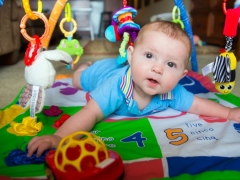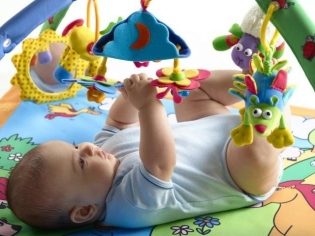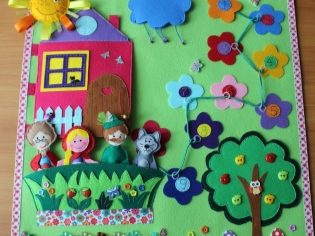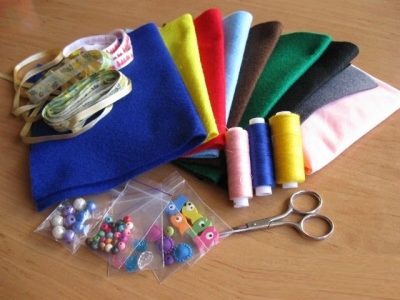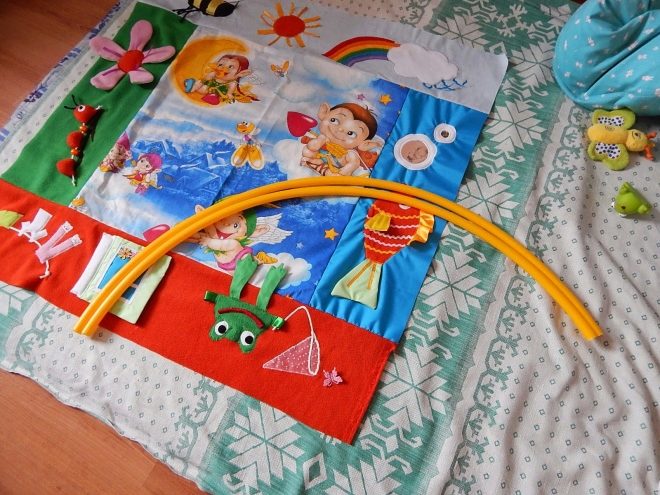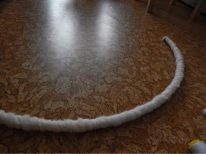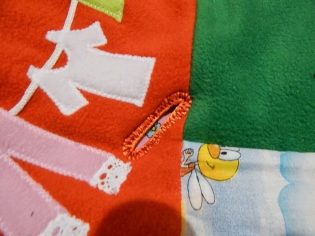Developing a rug for children do it yourself
When such a small miracle as a child appears in a family, young parents begin to think about how to ensure the correct physical, emotional and mental development of the baby. Faced with such a task, hard trips to children's shops begin in search of the right solution.
Nowadays, the modern industry for the production of didactic games, manuals and toys for children of different ages is not only at a high level, but continues to rapidly gain momentum. In particular, at the moment such a universal product as educational mats for children - they can be easily made independently.
One of the workshops on making a small round rug you can see below.
Purpose
The children's rug is a kind of first didactic manual for kids and parents. When developing such a product, the main idea was to place on the colorful and bright canvas of various sizes all kinds of developing elements: fabrics of different textures and colors, musical details, rattles, rodents, etc.
The purpose of this attribute is the development of hearing, motor activity, the cognitive sphere and the sensorimotor skills of the crumbs. With the help of such rugs, the child learns to reach the toys, crawl, sit, walk, and distinguish colors and shapes during the game.
It is important that the mat meets the following requirements:
- Materials must be of high quality. This requirement applies not only to the fabric, but also to the components, in order to avoid an allergic reaction in the baby.
- The integrity of the materials, i.e. the absence of various kinds of damage cracks, chips, poorly made seams, etc.
- The build quality of the product must be high. Decorative items and various accessories should not hang out, but should be firmly sewn and attached.
- The versatility of the canvas. As babies grow fast enough, it will be necessary to improve this children's accessory. It is worth paying attention to whether it is possible, if necessary, to change and supplement the developmental parts and toys on the purchased rug. For example, if such a developing product is sewn for newborns, babies up to 3 months and planned to be used in the future, the ideal choice would be models with folding soft sides and strong hinged arcs, to which various didactic materials can be attached. The presence of arcs and folding sides in this product makes it possible to modernize and increase game square.
- Age features of the child. It is not necessary to sew a cloth overflowing with musical and electronic elements to the baby, as well as making mats-puzzles. Kids of this age are just starting their acquaintance with the environment and are not able to think logically and establish cause-effect relationships.
- A variety of completing material. The more noisy, rustling, ringing, sensorimotor, moving, interactive, mirror, luminous, etc. elements that are different in texture, color, size and shape - the faster and easier the child becomes interested in the game. Such a canvas not only develops the baby, but also entertains him when the parents are busy and cannot pay attention to him for a while.
- Mobility. The ability, if desired, is easy to fold and transport this product.
- All elements of the children's educational rug should be easily removed and unfastened, especially music and electronic. This must be taken into account, as the cloth will sometimes need to be washed.
Searches for goods that would meet all the above requirements, can lead parents to such a result, where the price for such a children's attribute will be quite high. An excellent way out of this situation is to make such a development center yourself.
The process of sewing their own hands
Without a doubt, it is quite obvious and clear the benefits of such a product for the development of the baby. Therefore, if the choice is made in favor of a self-made center, you should work a little, be patient and imagination. And first you need to think and decide what the rug will look like and what option to choose to make it, so that the result will be an original attribute filled with parental love, care and warmth.
In order to prevent mistakes in the creation of the canvas and not to harm the baby, it is important to consider the following points:
First, the presence of mirrors on the rug is unacceptable. This is dangerous not only because the mirror can break or a part of it can be broken off, but also harmful to the baby’s view, because when reflected from the mirror surface, the light is 100% polarized.
- Subjects for fine motor fingers should not be monotonous. The child will quickly lose interest in this gaming activity. It is necessary to alternate between different textures to the touch. This is also necessary in order to fully develop the tactile sensations of the crumbs.
- For the basis of the canvas you should not choose rich monochromatic fabrics with a glossy effect. The eyes of the baby will quickly get tired and the passion for the game will disappear.
- When decorating the product it is important to consider the level of development of the crumbs. Do not be too detailed and complicate the composition. Better to leave some free space to further make the desired changes.
- Use in the manufacture of this children's attribute fabrics in both cold and warm shades. The colors should be bright, but not flashy.
- It is also important to think about which zones the canvas will be divided into. To select decorated elements in such a way that they look appropriate and reflect the idea of the plan.
Choose a model
Variations of children's educational paintings quite a lot. Focusing on your favorite model, it will be much easier to design your own, making it more perfect and individual.
Developing mini-sites can be classified as follows.
By age child
- For newborns. Cloth soft, bright. Be sure to have sides and arcs. Toys are arranged so that the baby can reach them. Additional elements are used in the form of soft laces, strips of fabric of different material, rattling and rustling toys. Often these rugs are produced according to the type of "transformers". If desired, they are quite easy to fold, can transform into a bag for toys or a cradle.
- For crumbs from 6 months to 1 year. Most often these are rugs with musical attributes. Baby at this time learning to sit, crawl and walk. There should be plenty of space for gaming activities. The child becomes more comfortable and fun to play on the floor. Proceeding from this, the developing canvas is sewn with a foam rubber or synthetic rubber insert. The bottom of this product - oilskin. This helps in cleaning it from possible impurities.
- For kids from 1 year. For children of this age, the choice can be made in favor of bilateral cloth. If you want to change the field of activity for the game, just turn the product. The baby - one-year-olds are also interested in music or electronic mats, as the baby quickly develops its auditory skills and dance movements.
- For children from 2 years old. At this time, the baby development of speech is gaining momentum.The subject - didactic environment of the playing field should stimulate the crumbs to activate vocabulary on topics: size, first colors, animals and sounds that they make. At this age is the formation of the plot - role-playing game. The ideal would be the choice of a developing attribute in the form of game houses and labyrinth tracks;
- For children from 3 years. At this age, children learn to establish causal relationships. The main activity - plot-role-playing game. Kids learn to find new uses for familiar toys. Logic and thinking are actively developing. Rugs - puzzles, complicated labyrinth tracks are very useful and interesting for children of this age.
With arcs and sides
Products of this model are quite common and in demand. Arcs, intersect each other, quite simply unfastened from the mat. They can hang various game elements, musical details, etc. The side stops are made of soft fabric, sometimes made in the form of rollers.
For boys and girls
Such canvases may differ in color, shape, component parts. Ways to make such gender mats, a huge amount. It all depends on the imagination and skills of the master, who undertook to create such a product.
The boys mostly use in the product shades of blue and blue and the image of road and construction equipment. Such "car mats" will help the child to get acquainted with the rules of the road. As an idea of decorating the canvas for young car enthusiasts, you can make a traffic light in which you need to choose the right colors and attach them with sticky tape or rivets. Worthy of the same will look and home-made machines, able to squeak or strum because of the small parts placed in them.
In decorating rugs for girls, red and pink colors are taken as a basis, dolls, flowers, hearts, etc. are depicted. Interesting and relevant for young ladies seem cloth with a bias on economic work: it is appropriate to use a variety of deep pockets, liners, inserts, appliqués in the form of stoves, cabinets, in which with a tape - stickies or rivets you can put small fabric pots and doll clothes.
In the form of puzzles
The most common paintings of this type are products made from polyvinyl chloride (PVC), as it is resistant to impacts, not rigid, long-term and heat-retaining. Thanks to the listed qualities of such raw materials, you can be sure that the child playing on the floor will be warm and comfortable.
There are textile mats, puzzles, which moms do with pleasure on their own.
Stages of work
Having decided on a model of a children's developmental mat, you can proceed directly to its manufacture. It will be much more convenient to work on the basis of an action plan.
The first stage is preparatory. At this stage, we need:
- To make a drawing of the playing canvas, taking into account all decorative additional elements and educational details.
- Pick up the fabric. When choosing a fabric, it is important to consider its hypoallergenicity. Such quality possess: cotton, coarse calico, denim material, bike, satin, felt. If the project has a knitted decor element, you must choose cotton yarn, as it is not only pleasant to the touch, but does not cause irritation on the tender skin of the child. Do not forget about foam or synthetic winterizer, which will allow the crumbs to play on a warm and soft canvas.
- Prepare all the necessary tools and accessories: scissors, needles, threads, applications, candy wrappers, buttons, ribbons, zippers, adhesive tape, laces, beads, etc.
The second stage - work with a cloth.
The game pad consists of two main parts - the back and front sides. Having decided on the fabric, shape and size of the product, we begin to make the pattern of the bottom and top of the canvas, not forgetting the indents for the seams. Next, you should carefully brush over the edges, making sure that there are no threads sticking out.
The third stage - work with decorative trim.
Selected fabric applications sew on top fabric, which is the basis of the rug. We perform the same actions with prepared furniture, rustling and sound parts, toys. When working with decorating the canvas, it is especially important to ensure that the elements to be attached are firmly attached.
The fourth stage is the completion of work.
At this stage, from the seamy side, the parts of the canvas are sewn - the base and the bottom. But in order for the rug to be soft, it is necessary to insert foam rubber or synthetic winterizer between the fabrics (if it is very thin, then two layers will be needed).
Master class on making a rug
Let's consider step by step how to make a developing rug with arcs for a newborn.
The manufacturing process can be viewed on the video:
Step one. Preparation of the necessary tools and materials.
Attention! Fabric for a cloth needs to be selected the most qualitative, for example, cotton. This material is quite durable and completely natural. Use to create products better fabrics of different colors - cold and warm colors.
- about 1 meter of monochromatic bright fabric on the bottom and the arc;
- 8 patches of fabric in polka dots, a flower, a strip, a check or any other pattern;
- cotton ribbons, satin ribbons or fabric strips (optional);
- gymnastic plastic wrap, the diameter of the arc of which will be approximately 65 cm;
- paper pattern in the form of a square with sides 45 cm long;
Attention! The sides of the square paper pattern will vary depending on the diameter of the selected hoop. If the arc is longer, the size of the product will be larger.
- scissors, needle, thread, stationery knife, pins;
- synthetic winterizer: 2 meters on arches and 1 meter on the basis of a cloth.
Step two. Pattern material.
Cut the first base - the bottom of the canvas.
On the selected fabric is superimposed a paper square, which is carefully enclosed with chalk or soap. On the sides you need to leave indents of about 1.5 - 2 cm, these are the so-called gaps for the seam. Next, the pattern should be cut.
Next - sew the upper part of the product.
It is necessary to fold the paper square 4 times diagonally so that a triangle is obtained. Next, it is alternately superimposed on 8 patches of fabric, then circled and cut. It is important not to forget about leaving a distance for stitching material. The result will be 8 fabric triangles. Of them will consist of the upper part of the rug.
Every two triangles are folded large sides to each other and stitched. The result of such actions will be 4 squares, which also need to be stitched together in such a way that at the end there will be one big square. All material should be stitched so that all seams remain inside.
Now you need to work with sintepon. From it should carve out two squares with sides of 50 cm.
The result of this stage of work will be finished top, soft base and bottom of the product.
Step three. Making arcs.
The selected hoop is divided into two equal parts with a clerical knife. Arcs are obtained, which should also be soft. To do this, pieces of a sintepon need to be attached to each half of the hoop, tightly pressing and winding them with a frequency of 2–3 cm. Further, such peculiar arches should be closed with a cloth and sheathed. However, in the middle of one of the arcs will need to insert two strips of braid, tape or fabric that will be tied at the top and hold the design.
Attention! The use of pins will greatly facilitate the work with the hoop parts, since they will fix the fabric and will not allow it to crawl.
Step Four. Creating "pockets" for arcs.
In order for the arcs to be firmly attached to the base of the rug, it is necessary to make four “pockets” of pieces of material. It is necessary to sew a kind of tubes, the width of which should be slightly larger than the diameter of the arc wrapped with padding polyester and fabric, and the length - approximately 10 - 12 cm.The arc should be free to enter the pocket, but not hang out.
Step five. Completion of work.
You must first sew the pockets at the corners of the canvas. Then you need to sew the bottom and top of the product inside out, with the front sides inward (like a pillowcase), leaving a small opening through which the padding polyester will fit. The base of the rug is ready.
Next you should set the arc. They should be inserted into the pockets, placed along the diagonal of the product, cross each other and connect at the top with sewn tape or braid. In order that the arcs do not jump out, you need to tightly wrap the pockets with arcs with the help of the material.
Developing a mat for newborns ready. It remains only with the help of satin ribbons or cotton braid to hang on the arc toys, teethers for gums or rattles.
The process of creating the next rug is presented in two parts. Be sure to take a look - you will see a lot of interesting ideas.
